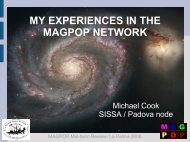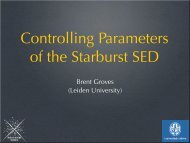Nitrogen and Carbon Abundances in Elliptical Galaxies - magpop
Nitrogen and Carbon Abundances in Elliptical Galaxies - magpop
Nitrogen and Carbon Abundances in Elliptical Galaxies - magpop
Create successful ePaper yourself
Turn your PDF publications into a flip-book with our unique Google optimized e-Paper software.
etj@astrax.fis.ucm.es<br />
jgorgas@fis.ucm.es<br />
IV MAGPOP<br />
MEETING<br />
<strong>Nitrogen</strong> <strong>and</strong> <strong>Carbon</strong><br />
<strong>Abundances</strong> <strong>in</strong><br />
<strong>Elliptical</strong> <strong>Galaxies</strong><br />
E. Toloba (UCM-Spa<strong>in</strong>)<br />
J. Gorgas(UCM-Spa<strong>in</strong>)<br />
P. Sánchez-Blázquez (UCLan-UK)<br />
B. Gibson(UCLan-UK)
INTRODUCTION I<br />
Ma<strong>in</strong> goal: study the star formation history <strong>in</strong> elliptical galaxies<br />
Classic<br />
Ages, Z’s from l<strong>in</strong>estrength<br />
<strong>in</strong>dices<br />
Difficulties<br />
Methods<br />
Alternative<br />
Element abundances<br />
Cosmic clocks
INTRODUCTION II<br />
• Mg <strong>in</strong> Es overabundant<br />
• Correlation Mg-σ <strong>in</strong>terpreted as shorter SF history <strong>in</strong> massive Es<br />
Mg ejected via type II SNs<br />
Fe ejected via type Ia SNs<br />
• CN <strong>and</strong> C4668 also stronger than <strong>in</strong> the solar neighbourhood<br />
• [C/Fe], [N/Fe] overabundant ? 1.5 2.5<br />
[Mg/Fe]~solar<br />
Up to now<br />
Sánchez-Blázquez et al. 2003<br />
Mgb <br />
[Mg/Fe]≥0.3dex<br />
logσ (Km/s)
Ponder et al. 1998<br />
Boulade et al. 1998<br />
PREVIOUS WORKS<br />
Worthey 1998<br />
Massive Es N overabundant???<br />
Galactic bulge chemically similar to Es<br />
Milky Way N underabundant <strong>in</strong> bulge<br />
Another type of SN for enhancement??<br />
4 M31’s GCs + 6 elliptical galaxies <strong>in</strong> NH<br />
Comparison with Galactic GCs & stars<br />
NO models<br />
M32 analysis<br />
[N/Fe] solar<br />
<br />
CN 1
CNO<br />
NH3360<br />
THIS WORK<br />
• They can help enormously to f<strong>in</strong>e tune the previous scenarios<br />
• C & N are necessary to calculate O abundance<br />
• Ma<strong>in</strong> contributors to the global metallicity (not studied <strong>in</strong> detailed)<br />
• Sánchez-Blázquez et al. 2003 → CN depends on environment<br />
d=–0.029±0.006<br />
d=–0.010±0.003<br />
• CN depends <strong>in</strong> a complex way on C, N <strong>and</strong> O<br />
Coma<br />
Field<br />
• To disentangle the CNO contributions by NH3360 (‘pure’ N)
2 Runs + 2 Service mode nights<br />
OBSERVATIONS<br />
WHT-ISIS<br />
7 nights<br />
Subsample Sánchez-Blázquez et al. 2006 (λ 3500-5250A)<br />
Instrumental configuration:<br />
Slit width 3’’<br />
5300A dichroic<br />
R1200B grat<strong>in</strong>g<br />
λ-range: 3140-4040A!<br />
t~1800-7400s<br />
36 <strong>Elliptical</strong>s<br />
14 Coma 22 Field<br />
St<strong>and</strong>ard reduction procedure: REDUCEME (Cardiel 1999)
2 Runs + 2 Service mode nights<br />
OBSERVATIONS<br />
NH3360<br />
Instrumental configuration:<br />
WHT-ISIS<br />
NGC 1700<br />
S/N ~ 50<br />
7 nights<br />
Subsample Sánchez-Blázquez et al. 2006 (λ 3500-5250A)<br />
5300A dichroic<br />
R1200B grat<strong>in</strong>g<br />
λ-range: 3140-4040A!<br />
t~1800-7400s<br />
37 <strong>Elliptical</strong>s<br />
14 Coma 23 Field<br />
St<strong>and</strong>ard reduction procedure: REDUCEME (Cardiel 1999)
RESULTS I<br />
Stacked spectra- Comparison with the models<br />
C (-O) C, N, -O<br />
CO4685 CNO4175<br />
Coma Field<br />
N (C, -O) N<br />
CNO3862 NH3360<br />
Indices def<strong>in</strong>ed by<br />
Serven,Worthey<br />
& Briley 2005<br />
• [N/Fe] sligthly<br />
oversolar<br />
• Strong [C/Fe]<br />
overabundance <strong>in</strong><br />
field galaxies (but<br />
not <strong>in</strong> Coma)<br />
Index def<strong>in</strong>ed by<br />
Davidge & Clark<br />
1994
Model predictions<br />
Bruzual & Charlot 2007 models<br />
CO4685<br />
The rest of the CNO <strong>in</strong>dices (<strong>and</strong><br />
Mg 2) depend strongly on age <strong>and</strong><br />
metallicity<br />
For the typical metallicities<br />
of elliptical galaxies (Z > 0.004),<br />
NH3360 is essentially<br />
constant with age <strong>and</strong> overall<br />
metallicity.<br />
CNO4175
Coma Field RESULTS II<br />
N<br />
N (C,-O)<br />
C N(-O)<br />
C (-O)<br />
log σ<br />
Index-σ relations<br />
<strong>Nitrogen</strong> abundances are not<br />
correlated with mass (contrary to<br />
expectations) → <strong>Nitrogen</strong> is primary<br />
In primary nucleosynthesis, N is produced at the same time as C <strong>and</strong><br />
O <strong>and</strong> it is <strong>in</strong>dependent of metallicity while <strong>in</strong> secondary production N is<br />
synthesized from the C <strong>and</strong> O already present <strong>in</strong> the star, <strong>and</strong> its<br />
abundance is therefore proportional to the heavy elements abundance.<br />
No differences <strong>in</strong> N content between<br />
Coma <strong>and</strong> field galaxies<br />
Mg
CONCLUSIONS<br />
Us<strong>in</strong>g NH3360 we have separated the C & N contributions<br />
C overabundance <strong>in</strong> massive <strong>Elliptical</strong>s<br />
Correlates with σ<br />
Differences with environment<br />
Formation of field E from a previously C-enriched gas.<br />
Coma E were fully assembled before the massive release of C<br />
A richer star formation history <strong>in</strong> field E compared to Coma.<br />
N is mildly enhanced (with respect to solar ratio)<br />
NH3360 does NOT correlate with σ (PRIMARY)<br />
No differences with environment<br />
N is produced by massive <strong>and</strong> <strong>in</strong>termediate-mass stars (enrichment delay w.r.t. to Mg)<br />
C is likely produced <strong>in</strong> massive stars <strong>and</strong> lower mass stars<br />
Field galaxies have experienced a more extended SF history<br />
time C<br />
Mg N C<br />
N<br />
Fe






